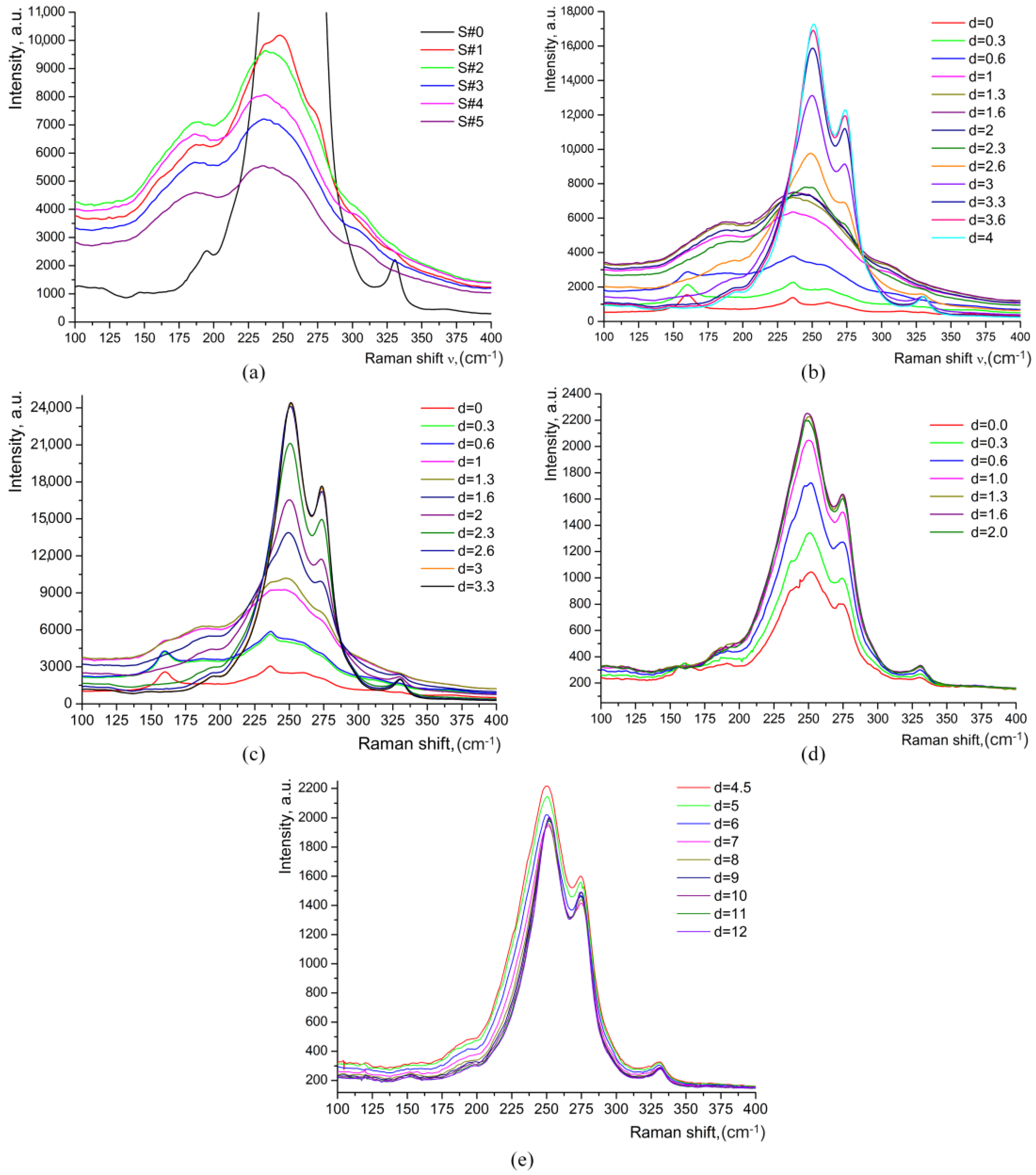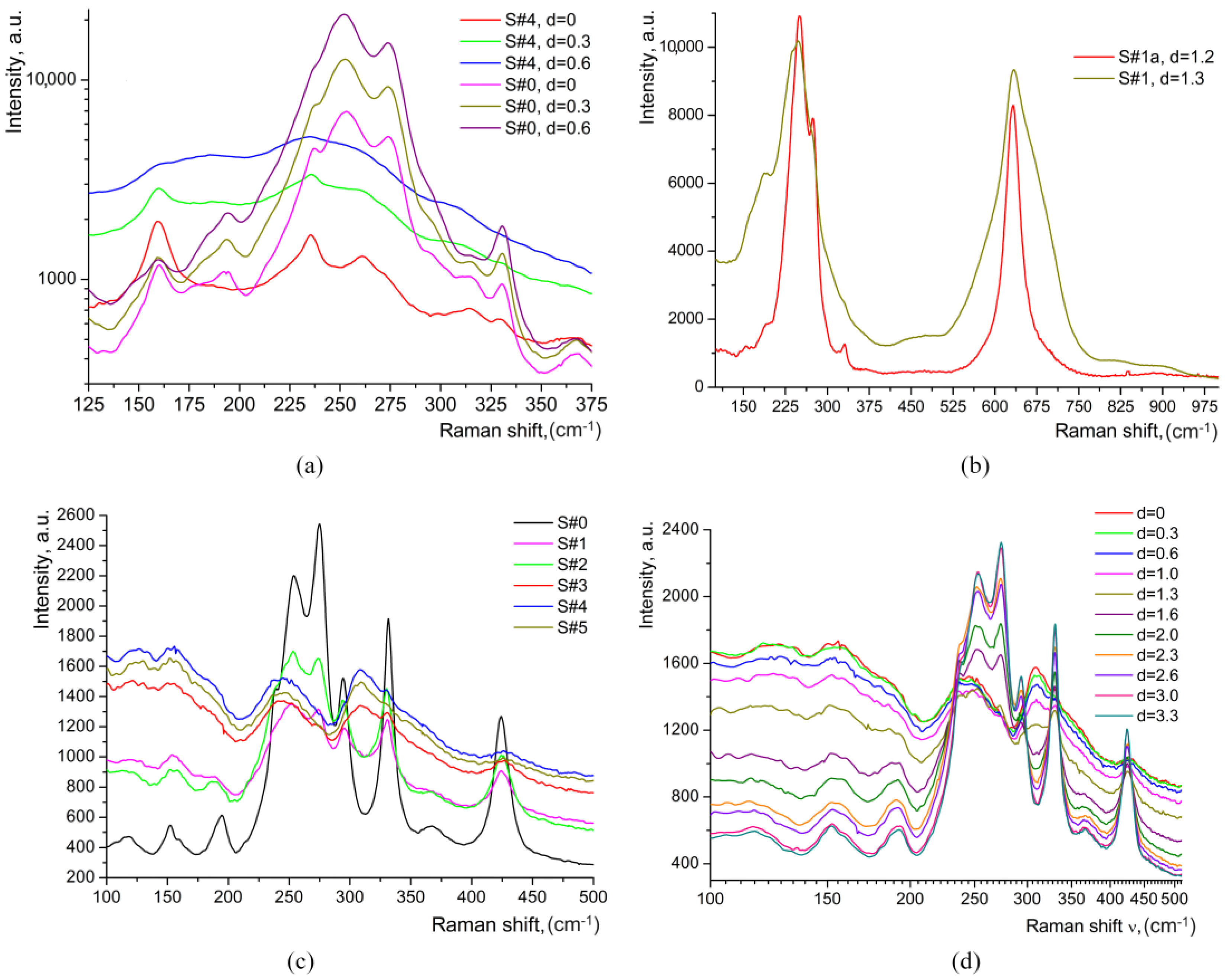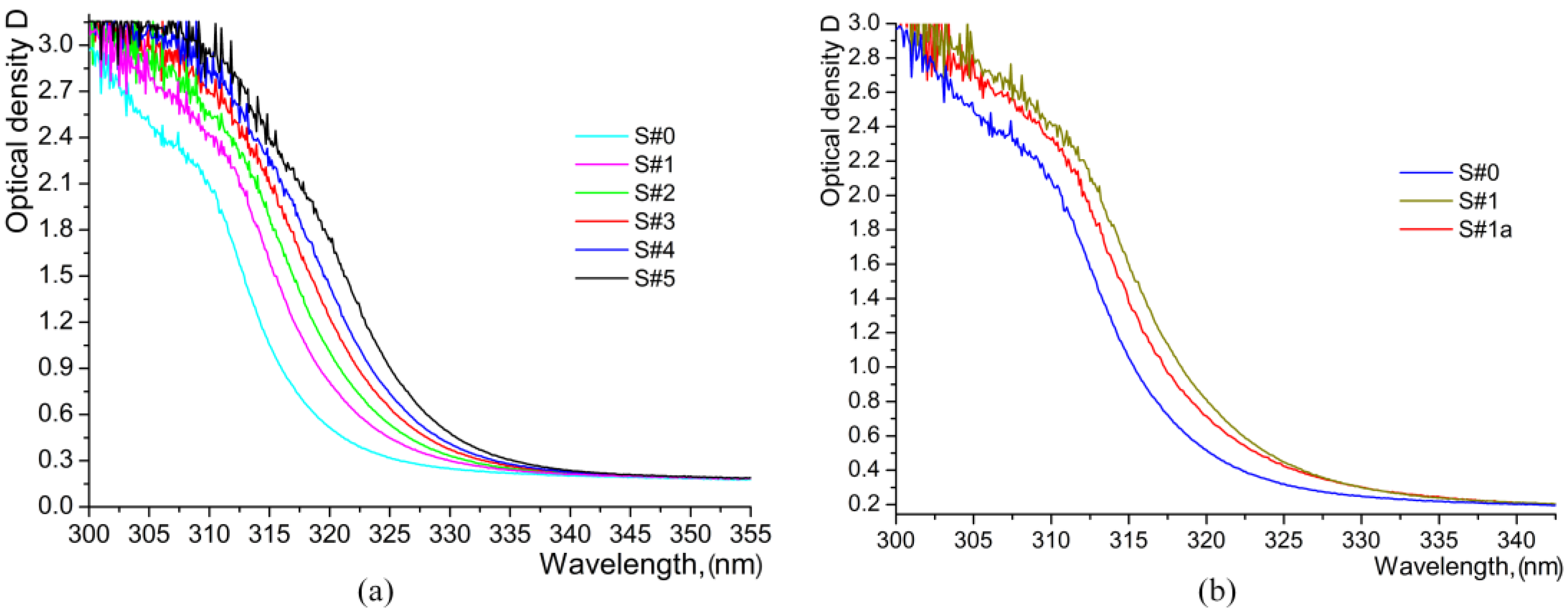Phase Composition of HiVac-VPE Lithium Niobate Optical Waveguides Identified by Spectroscopic Investigations
Abstract
:1. Introduction
2. Samples Fabrication and Index Profiles Reconstruction
3. Results and Discussion
3.1. Raman Spectroscopy
3.2. IR Reflection Spectroscopy
3.3. IR Absorption Spectroscopy
3.4. UV-VIS Absorption
4. Conclusions
Author Contributions
Funding
Institutional Review Board Statement
Informed Consent Statement
Data Availability Statement
Conflicts of Interest
References
- Rambu, A.P.; Apetrei, A.M.; Doutre, F.; Tronche, H.; Tiron, V.; De Micheli, M.; Tascu, S. Lithium niobate waveguides with high-index contrast and preserved nonlinearity fabricated by high vacuum vapor-phase proton exchange. Photonics Res. 2020, 8, 8–16. [Google Scholar] [CrossRef]
- Rambu, A.P.; Apetrei, A.M.; Tascu, S. Role of the high vacuum in the precise control of index contrasts and index profiles of LiNbO3 waveguides fabricated by high vacuum proton exchange. Opt. Laser Technol. 2019, 118, 109–114. [Google Scholar] [CrossRef]
- Rambu, A.P.; Apetrei, A.M.; Doutre, F.; Tronche, H.; De Micheli, M.; Tascu, S. Analysis of High-Index Contrast Lithium Niobate Waveguides Fabricated by High Vacuum Proton Exchange. J. Light. Technol. 2018, 36, 2675–2684. [Google Scholar] [CrossRef]
- Lenzini, F.; Kasture, S.; Haylock, B.; Lobino, M. Anisotropic model for the fabrication of annealed and reverse proton exchanged waveguides in congruent lithium niobate. Opt. Express 2015, 23, 1748–1756. [Google Scholar] [CrossRef] [PubMed]
- Nikolopoulos, J.; Yip, G.L. Theoretical modeling and characterization of annealed proton-exchanged planar waveguides in z-cut LiNbO3. J. Light. Technol. 1991, 9, 864–870. [Google Scholar] [CrossRef]
- Passaro, A.; Franco, M.A.R.; Abe, N.M.; Sircilli, F. The effect of the proton-concentration-to-refractive-index models on the propagation properties of APE waveguides. J. Light. Technol. 2002, 20, 1573–1577. [Google Scholar] [CrossRef]
- De Almeida, J.M.M. Design methodology of annealed H+ waveguides in ferroelectric LiNbO3. Opt. Eng. 2007, 46, 064601. [Google Scholar] [CrossRef]
- Vohra, S.T.; Mickelson, A.R.; Asher, S.E. Diffusion characteristics and waveguiding properties of proton-exchanged and annealed LiNbO3 channel waveguides. J. Appl. Phys. 1989, 66, 5161–5174. [Google Scholar] [CrossRef]
- Kostritskii, S.M.; Korkishko, Y.N.; Fedorov, V.A.; Sevostyanov, O.G.; Chirkova, I.M. Raman Spectra and Electro-Optic Properties of Proton-Exchanged Channel Waveguides in Lithium Niobate Crystals; SibRaman Seminar IAE: Novosibirsk, Russia, 2015. [Google Scholar]
- Kuneva, M.; Tonchev, S.; Gorgorov, R. Approaches in Characterization of Li1−xHxNbO3 Optical Waveguide Layers. In Advances in Microelectronics: Reviews; International Frequency Sensor Association Publishing: Barcelona, Spain, 2019; pp. 183–220. [Google Scholar]
- Kuneva, M.; Tonchev, S. Spectroscopy of optical waveguiding layers. Bulg. Chem. Commun. 2011, 43, 276–287. [Google Scholar]
- Savatinova, I.; Tonchev, S.; Liarokapis, E.; Armenise, M.N.; Armenise, M. Evidence of different β-phases in highly protonated z-cut H:LiNbO3 waveguides by Raman scattering. Appl. Phys. A 1999, 68, 483–487. [Google Scholar] [CrossRef]
- Savova, I.; Savatinova, I.; Liarokapis, E. Phase composition of Z-cut protonated LiNbO3: A Raman study. Opt. Mater. 2001, 16, 353–360. [Google Scholar] [CrossRef]
- Savova, I.; Savatinova, I.; Kircheva, P.; Liarokapis, E. Raman characterization of H:LiNbO3 waveguides. Appl. Phys. B 2001, 73, 565–568. [Google Scholar] [CrossRef]
- Kostritskii, S.M.; Korkishko, Y.N.; Fedorov, V.A.; Mitrokhin, V.P.; Sevostyanov, O.G.; Chirkova, I.M.; De Micheli, M.; Stepanenko, O. Subsurface disorder and electro-optical properties of proton-exchanged LiNbO3 waveguides produced by different techniques. J. Eur. Opt. Soc. 2014, 9, 14055. [Google Scholar] [CrossRef]
- Kostritskii, S.M.; Rodnov, S.V.; Korkishko, Y.N.; Fedorov, V.A.; Sevostyanov, O.G. Electro-optical properties of different HxLi1-xNbO3 phases in proton-exchanged LiNbO3 waveguides. Ferroelectrics 2012, 440, 47–56. [Google Scholar] [CrossRef]
- Paz-Pujalt, G.R.; Tuschel, D.D.; Braunstein, G.; Blanton, T.; Tong Lee, S.; Salter, L.M. Characterization of proton exchange lithium niobate waveguides. J. Appl. Phys. 1994, 76, 3981–3987. [Google Scholar] [CrossRef]
- Fu, Y.-L.; Wu, Y.-C.; Yuan, Y.F.; Chen, B.X. Raman spectra of proton-exchanged LiNbO3 optical waveguides. Chin. Phys. Lett. 2004, 21, 1292–1293. [Google Scholar]
- Korkishko, Y.N.; Fedorov, V.A.; Kostritskii, S.M. Optical and X-ray characterization of HxLi1−xNbO3 phases in proton-exchanged LiNbO3 optical waveguides. J. Appl. Phys. 1998, 84, 2411–2419. [Google Scholar] [CrossRef]
- Korkishko, Y.N.; Fedorov, V.A. Relationship between refractive indices and hydrogen concentration in proton exchanged LiNbO3 waveguides. J. Appl. Phys. 1997, 82, 1010–1017. [Google Scholar] [CrossRef]
- Kuneva, M. Surface phase detection of proton-exchanged layers in LiNbO3 and LiTaO3 by IR reflection spectroscopy. Bulg. Chem. Commun. 2013, 45, 474–478. [Google Scholar]
- Rong, S.; Wen, X.; Ding, N.; Liao, J.; Hua, P. X-Cut Lithium Niobate Optical Waveguide with High-Index Contrast and Low Loss Fabricated by Vapor Proton Exchange. Photonics 2023, 10, 1390. [Google Scholar] [CrossRef]
- Yasemin Aşık, F.; Gökkavas, M.; Öztekin, E.; Karagöz, E.; Ceylan, A.; Özbay, E. Optimization of the annealed proton exchange method with controlled annealing for multifunctional integrated optical chip production. Appl. Opt. 2022, 61, 8898–8903. [Google Scholar] [CrossRef] [PubMed]
- Kuneva, M.; Tonchev, S.; Christova, K. Phase Composition and Stress in Proton Exchanged Waveguide Layers in LiNbO3 and LiTaO3. In Newest Updates in Physical Science Research; BP International: New York, NY, USA, 2021; pp. 140–151. [Google Scholar]
- Stepanenko, O.; Quillier, E.; Tronche, H.; Baldi, P.; De Micheli, M. Crystallographic and Optical Properties of Z-Cut High Index Soft Proton Exchange (HISoPE) LiNbO3 Waveguides. J. Light. Technol. 2016, 34, 2206–2212. [Google Scholar] [CrossRef]
- Bazzan, M.; Sada, C. Optical waveguides in lithium niobate: Recent developments and applications. Appl. Phys. Rev. 2015, 2, 040603. [Google Scholar] [CrossRef]
- Stepanenko, O.; Quillier, E.; Tronche, H.; Baldi, P.; De Micheli, M. Highly confining proton exchanged waveguides on Z-cut LiNbO3 with preserved nonlinear coefficient. IEEE Photon. Technol. Lett. 2014, 26, 1557–1560. [Google Scholar] [CrossRef]
- Surovtsev, N.V.; Pugachev, A.M.; Malinovsky, V.K.; Shebanin, A.P.; Kojima, S. Low-frequency Raman spectra in LiNbO3: Within and beyond the standard paradigm of ferroelectric dynamics. Phys. Rev. B 2005, 72, 104303. [Google Scholar] [CrossRef]
- Kalampounias, A. Low-frequency Raman scattering in alkali tellurite glasses. Bull. Mater. Sci. 2008, 31, 781–785. [Google Scholar] [CrossRef]
- Anikiev, A.A.; Umarov, M.F.; Scott, J.F. Processing and characterization of improved congruent lithium niobate. AIP Adv. 2018, 8, 115016. [Google Scholar] [CrossRef]
- Passaro, V.M.N.; Armenise, M.N.; Nesheva, D.; Savatinova, I.T.; Pun, E.Y.B. LiNbO3 Optical Waveguides Formed in a New Proton Source. J. Light. Technol. 2002, 20, 71–77. [Google Scholar] [CrossRef]
- Korkishko, Y.N.; Fedorov, V.A.; Baranov, E.A.; Proyaeva, M.V.; Morozova, T.V.; Caccavale, F.; Segato, F.; Sada, C.; Kostritskii, S.M. Characterization of α-phase soft proton-exchanged LiNbO3 optical waveguides. J. Opt. Soc. Am. A 2001, 18, 1186–1191. [Google Scholar] [CrossRef] [PubMed]
- Kostritskii, S.M.; Korkishko, Y.N.; Fedorov, V.A.; Proyaeva, M.V.; Baranov, E.A. Spontaneous polarization and nonlinear susceptibility in various protonated HxLi1−xNbO3 phases. Tech. Phys. 2002, 47, 74–79. [Google Scholar] [CrossRef]
- Bates, J.B.; Wang, J.C.; Perkins, R.A. Mechanisms for hydrogen diffusion in TiO2. Phys. Rev. B 1979, 19, 4130–4137. [Google Scholar] [CrossRef]
- Ahlfeldt, H.; Webjorn, J.; Thomas, P.A.; Teat, S.J. Structural and optical properties of annealed proton-exchanged waveguides in z-cut LiTaO3. J. Appl. Phys. 1995, 77, 4467–4476. [Google Scholar] [CrossRef]
- Fridkin, V.M.; Kochev, K.D.; Kusminov, Y.S.; Verkhovskaya, K.A.; Volk, T.R. The shift of the optical absorption edge at “optical damage” in LiNbO3. Phys. Status Solidi A 1976, 33, K137–K139. [Google Scholar] [CrossRef]
- Di Domenico, M.; Wemple, S.H. Oxygen-octahedra ferroelectrics. I. Theory of electro-optical and nonlinear optical effects. J. Appl. Phys. 1969, 40, 720–732. [Google Scholar] [CrossRef]
- Bhatt, R.; Bhaumik, I.; Ganesamoorthy, S.; Karnal, A.K.; Swami, M.K.; Patel, H.S.; Gupta, P.K. Urbach tail and bandgap analysis in near stoichiometric LiNbO3 crystals. Phys. Status Solidi A 2012, 209, 176–180. [Google Scholar] [CrossRef]
- Mendez, A.; de la Paliza, G.; García-Cabañes, A.; Cabrera, J.M. Comparison of the electro-optic coefficient r33 in well-defined phases of proton exchanged LiNbO3 waveguides. Appl. Phys. B 2001, 73, 485–488. [Google Scholar] [CrossRef]














| Sample | Exchange Duration t(h) | Δne |
|---|---|---|
| S#1 | 1 h | 0.1014 |
| S#2 | 2 h | 0.1027 |
| S#3 | 3 h | 0.1031 |
| S#4 | 4 h | 0.1033 |
| S#5 | 5 h | 0.1034 |
| Phase | I690/I630 [13] | I690/(I630 + I690) [13] | I690/(I630 + I690) [9] | νx(cm−1) [9] |
|---|---|---|---|---|
| κ1 | 0.43 ÷ 0.58 | 0.31 ÷ 0.37 | 0.19 ÷ 0.30 | 645 ÷ 654 |
| κ2 | 0.72 ÷ 0.79 | 0.42 ÷ 0.46 | 0.34 ÷ 0.46 | 657 ÷ 669 |
| β1 | 0.96 ÷ 1.10 | 0.48 ÷ 0.52 | 0.48 ÷ 0.52 | 687.5 |
| β2 | 1.23 | 0.55 | 0.55 | 687.5 |
| β3 and β4 | 1.64 | 0.62 | 0.62 | 690 |
| Sample | t (h) | dk2/dk1/dα (μm) (m-Lines Data [1]) | Plateau in Plot I690/(I630 + I690) vs. t | dk2 (μm) | dk1 (μm) | dα (μm) |
|---|---|---|---|---|---|---|
| S#1 | 1 | 0.62/1.1/3.3 | 1.3 | 1.6 | 2.3 | 3.3 |
| S#1a | 1 and 4 h (annealing) | - | - | - | - | ≈9.0 |
| S#2 | 2 | 1.78/2.1/4.4 | 1.76 | 2.3 | 2.6 | 4.3 |
| S#3 | 3 | 2.30/3.5/6.6 | 2.39 | 2.6 | 3.0 | 5.0 |
| S#4 | 4 | 2.80/4.0/6.6 | 2.71 | 3.6 | 4.3 | 6.0 |
| S#5 | 5 | 3.30/4.6/10.9 | 3.29 | 3.6 | 4.3 | >8.0 |
| Sample | Apparent Edge (nm) | AE (nm) | Eg,n (eV) | ΔEg,n (eV) | r13,n′ |
|---|---|---|---|---|---|
| S#0 | 315.30 | 318.55 | 3.936 | 0 | 1 |
| S#1a | 317.20 | 321.05 | 3.908 ÷ 3.914 | −(0.022 ÷ 0.028) | 0.76 ÷ 0.79 |
| S#1 | 318.33 | 322.10 | 3.887 ÷ 3.893 | −(0.043 ÷ 0.049) | 0.66 ÷ 0.69 |
| S#2 | 320.04 | 323.80 | 3.873 ÷ 3.877 | −(0.059 ÷ 0.063) | 0.58 ÷ 0.60 |
| S#3 | 321.60 | 325.25 | 3.854 ÷ 3.858 | −(0.078 ÷ 0.082) | 0.48 ÷ 0.50 |
| S#4 | 322.67 | 326.37 | 3.838 ÷ 3.842 | −(0.094 ÷ 0.098) | 0.40 ÷ 0.42 |
| S#5 | 324.30 | 327.85 | 3.830 ÷ 3.834 | −(0.102 ÷ 0.106) | 0.36 ÷ 0.38 |
Disclaimer/Publisher’s Note: The statements, opinions and data contained in all publications are solely those of the individual author(s) and contributor(s) and not of MDPI and/or the editor(s). MDPI and/or the editor(s) disclaim responsibility for any injury to people or property resulting from any ideas, methods, instructions or products referred to in the content. |
© 2024 by the authors. Licensee MDPI, Basel, Switzerland. This article is an open access article distributed under the terms and conditions of the Creative Commons Attribution (CC BY) license (https://creativecommons.org/licenses/by/4.0/).
Share and Cite
Rambu, A.P.; Kostritskii, S.; Fedorov, V.; Sevostyanov, O.; Chirkova, I.; Tascu, S. Phase Composition of HiVac-VPE Lithium Niobate Optical Waveguides Identified by Spectroscopic Investigations. Materials 2024, 17, 2249. https://doi.org/10.3390/ma17102249
Rambu AP, Kostritskii S, Fedorov V, Sevostyanov O, Chirkova I, Tascu S. Phase Composition of HiVac-VPE Lithium Niobate Optical Waveguides Identified by Spectroscopic Investigations. Materials. 2024; 17(10):2249. https://doi.org/10.3390/ma17102249
Chicago/Turabian StyleRambu, Alicia Petronela, Sergey Kostritskii, Vyacheslav Fedorov, Oleg Sevostyanov, Irina Chirkova, and Sorin Tascu. 2024. "Phase Composition of HiVac-VPE Lithium Niobate Optical Waveguides Identified by Spectroscopic Investigations" Materials 17, no. 10: 2249. https://doi.org/10.3390/ma17102249





